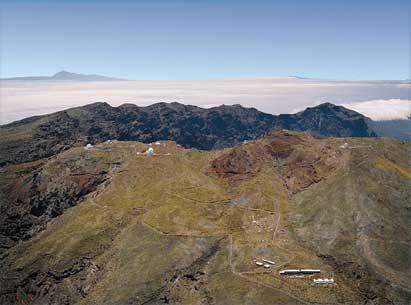GRANTECAN, Eye of the Canaries

After the advances of the last century, astrophysics faces numerous enigmas. Their clarification or not may depend on tools of observation of the universe. The most advanced countries are building large telescopes in the best viewpoints on Earth to solve unanswered questions. The Canary Institute of Astrophysics has promoted the project of building an advanced telescope for placement on the island of La Palma. The project is called Gran Telescopio de Canarias or Grantecan. Its owners are the governments of the Canary Islands and the Spanish State, but it also has the participation of numerous international organizations and companies, including some Basque.
Thanks to Grantecan, the origin and evolution of planetary systems, stars or galaxies, as well as those of the universe, can be better known to study the structure of the universe, that is, its shape, size, age, etc. The ability of your primary mirror allows you to see separately the objects that are overlapped by being far away. In addition, it will look for dark matter to know its origin, being able to find unknown or unforeseen objects.
It will be the largest telescope in the world. Its metal dome has been made in Vitoria-Gasteiz, in the company URSSA. The dome is a rotating structure inside which the telescope camera is stored. It is made of steel, with an inner diameter of 33 meters and a total weight of 500 tons. It has two mobile ports to make observations. In addition, it has 16 mobile windows for interior ventilation. It also has a folding screen to protect the telescope on windy days. To reduce the heat of the sun will be thermally insulated. You will have air conditioning during the day so that the temperature of the camera is the same as that of the night. This will prevent thermal turbulence and alter the quality of the telescope images.
Three mirrors
The primary mirror of Grantecan will consist of 36 hexagonal mirrors as mosaic. Each of them will have a maximum length of 1.9 meters diagonally and, together, a surface equivalent to a conventional mirror of 10 meters. The mobile optics of this mirror balance the deformations that can produce temperature changes and mechanical stresses. From the central computer you can control the position, inclination and deformation of each mirror compared to the others. Thus, the reflective assembly will be the perfect paraboloid.
The secondary mirror has a diameter of 1.8 meters and a movement based on five axes. This will allow you to align with the primary mirror automatically and correct the small deformations that occur due to the enormous structure of the telescope. You will also be prepared to perform small high-frequency inclinations that allow to balance the vibrations that can occur in the set due to wind blows. Ikerlan, MCC research centre, and the Pamplona company MTORRES, studied different alternatives for the drives of this secondary mirror, and the Bilbao company SENER analyzed one of the movement systems of the mechanical structure.
The optical system of the telescope is designed to take full advantage of observation time so as not to waste time making manual movement changes. Therefore, to change the type of observation it is not necessary to change the secondary mirror.
The tertiary mirror can be tumbled and controlled automatically with the controls, so without wasting time the light can be transferred to each of the 6 spotlights of the telescope. The presence of these spotlights will allow the placement of different tools in each of them. The design and execution of the turning system of these spotlights has been the work of the Eibar Tekniker technology centre.
With the ability to automatically modify the configuration of the telescope, the computer of the control system, depending on the weather conditions, will select the type of observation and the most suitable equipment. Therefore, it will often not be necessary for the astronomer to be present on the telescope, so that the entities that use it can save money and time.
World reference
In the Canary Islands, the international observatories of Teide and Roque de los Muchachos have 20 telescopes owned by 30 organizations from 13 countries. Therefore, these observatories are a reference for astronomers around the world. The quality of the sky in the Canary Islands makes the observatories of the Instituto de Astrofísica de Canarias an astronomical reserve.
The exact location of the telescope has been the subject of research and significant investment in scientific and technical infrastructure. Therefore, once completed, the complete exploitation of the particular technical characteristics of Grantecan is guaranteed.
In short, this telescope is an industrial project of high technological value that will result in an excellent scientific tool that will begin to operate at the end of 2003.
Buletina
Bidali zure helbide elektronikoa eta jaso asteroko buletina zure sarrera-ontzian


